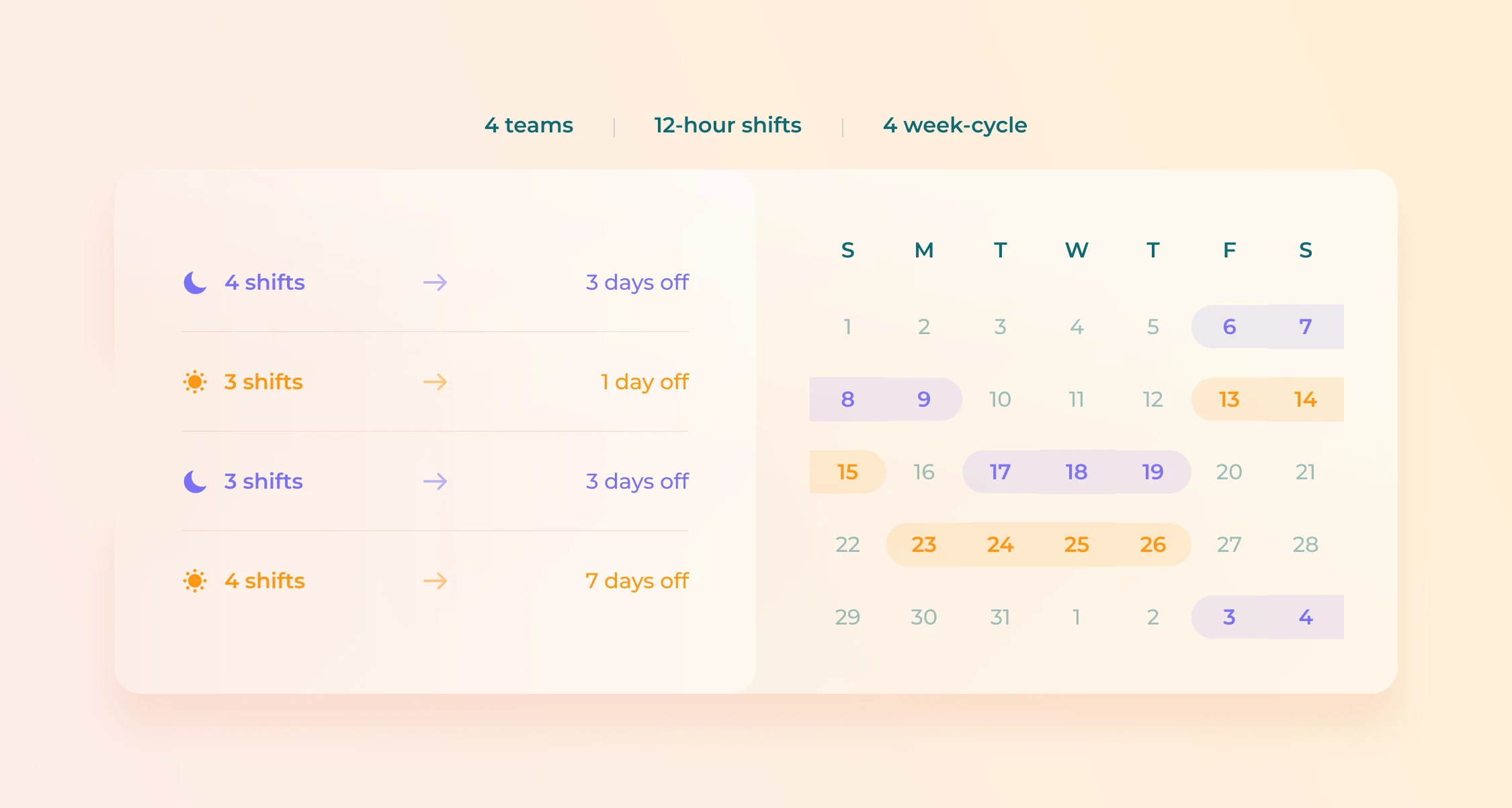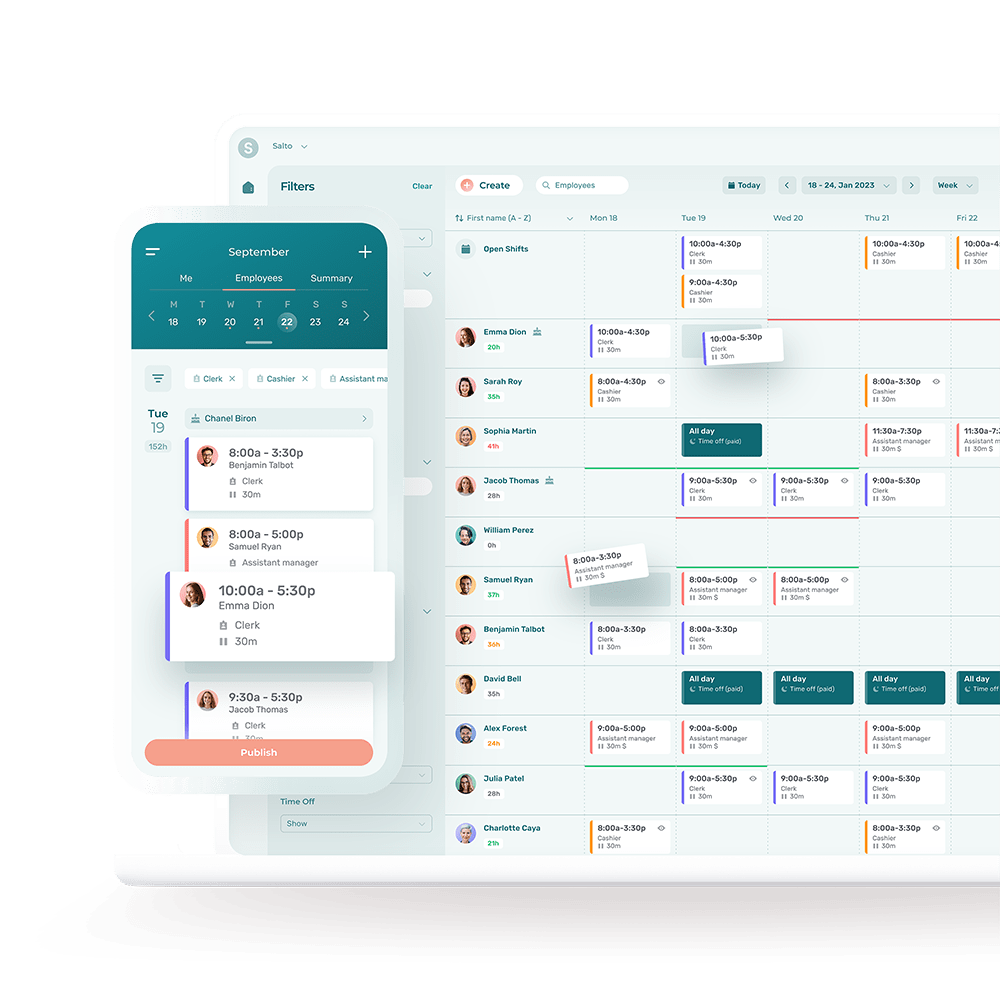DuPont Schedule Method: Pros, Cons & Tips to Implement it in Your Organization
Creating the right work schedule is crucial for business performance. It impacts productivity, job satisfaction, customer satisfaction, and the bottom line.
The DuPont shift schedule is a popular choice for 24/7 businesses as it improves employee morale and reduces turnover. Learn the ins-and-outs of the DuPont schedule and see if it’s right for your business.
What Is a DuPont Schedule?
The DuPont schedule is a rotating shift pattern commonly used in 24/7 industries. Four teams work two 12-hour shifts over a 28-day repeat cycle. Each employee works four night shifts, three days off, three day shifts, one day off, three night shifts, three days off and four day shifts. In the fourth week of this shift sequence, workers get seven consecutive days off.
A DuPont shift pattern gives employers round-the-clock shift coverage while giving employees a full week vacation each month. However, the extended shift length and changing schedule can disrupt sleep patterns and negatively impact employees’ life work balance. Some companies offer additional benefits or accommodations when employees work a DuPont schedule to address these challenges.
Who Uses the DuPont Schedule?
The DuPont schedule is used in a variety of industries that require 24/7 coverage or extended hours of operation:
- Manufacturing companies
- Healthcare
- Public safety, such as police departments
- Transportation
A DuPont shift schedule is also commonly used in industries with continuous processes, such as:
- Chemical plants
- Oil refineries
- Power generation facilities
12 Biggest Benefits of Using the DuPont Shift Schedule
Benefits of the DuPont Schedule for Managers
1. Potential for Increased Profitability
Being open round-the-clock can improve your bottom line. Some organizations, such as police departments and manufacturing companies are obligated to operate 24/7. Others, like gas stations, stay open night and day to serve more customers and boost revenues. A DuPont shift schedule can be a good way to achieve this.
2. Teams Are More Productive
By settling into twelve hour shifts, teams tend to become more efficient and productive as they get “locked into” their function. In contrast, eight-hour shifts can result in wasted “ramp-up time” as workers need to re-engage with their tasks every day. This slower rotation can significantly improve productivity.
3. More Accountability
Twelve-hour shifts mean fewer teams and shifts to schedule. This can improve accountability as errors, miscommunication, gaps, and related issues can be more easily tracked. On the other hand, the 8-hour model with additional shifts can result in more gaps and discrepancies.
4. Less Absenteeism
Combining twelve hour shifts with fewer shifts and teams can help reduce absenteeism. Shift workers feel a greater sense of responsibility to show up for their shift and bear their workload.
Stat: Companies running twelve hour shifts report a 10% lower absenteeism rate compared to those running eight hour shifts.
Benefits of the DuPont Schedule for Workers
5. More Days Off
In a typical work schedule, full-time employees work 40 hours a week over five days, with eight days off per month. However, a DuPont shift schedule requires employees to work longer, 42-hour weeks.
In exchange, they get 15 days off every four weeks, nearly twice as many as in a typical schedule—making spending time with friends and family easier.
This extended time off is a major advantage of the DuPont shift schedule, as it makes it easier to plan vacations, family events, and other activities with plenty of advance notice.
6. Less Risk of Burnout
The distribution of night shifts is evenly spread across teams, which lowers the likelihood of employee dissatisfaction and burnout.
7. Less Commuting Time and Expenses
Working longer shifts over fewer days means less traveling back and forth between work and home. What’s more, twelve hour shifts often start and begin during non peak-traffic hours, which further reduces commute time and consequently, stress.
8. More Flexibility
Another benefit of the extra days off employees get with the DuPont shift schedule is the added ease of scheduling personal appointments, attending to family responsibilities, pursuing other interests, etc. vs. those who work a traditional Monday to Friday 9 to 5 workweek.
9. Consistent Work Schedule
The DuPont schedule provides a consistent and predictable work schedule. Employees work the same shift sequence over a four week cycle.
10. Increased Job Satisfaction
Having more days off and a consistent work schedule can lead to increased job satisfaction and work-life balance.
11. Greater Sense of Responsibility
With fewer teams and shifts, employees may feel a greater sense of responsibility to show up for their shifts and perform their job duties well.
12. Potential for Increased Pay
DuPont shift schedules sometimes offer higher hourly pay rates for longer shifts, which can result in increased earnings for employees.
Easily manage employees and their schedules while keeping labor costs on budget. Download our Free Excel Schedule Template for Employee Scheduling
10 Major Drawbacks of the DuPont Schedule
Drawbacks of the DuPont Shift Schedule for Managers
1. Limited Flexibility
The rigid nature of the schedule can make it difficult for managers to accommodate last-minute changes or time off requests from employees.
2. Increased Training Costs
With fewer shifts and teams, managers may need to invest more time and resources in training new employees to ensure they can perform all necessary tasks during their longer shifts.
3. Reduced Overlap
Fewer shifts and teams also means there may be less overlap between shifts, which can make it more difficult for managers to communicate important information or ensure a smooth handoff of responsibilities.
4. Potential for Increased Overtime
If unexpected events or circumstances arise (such as a last-minute no-show), managers may need to ask employees to work additional hours, which can result in unplanned overtime pay.
5. Potential for Employee Burnout
Employees working 12-hour rotating shifts may become fatigued and less effective, particularly when alternating between day and night shifts. According to Circadian, day shifts tend to be more demanding, leading to higher levels of stress.
6. Potential for Safety Risks
Twelve hour shifts may be too long for some individuals to maintain continual vigilance and effectiveness. This can be a safety concern if their position requires them to remain attentive to avoid workplace accidents or injuries.
Drawbacks of the DuPont Shift Schedule for Workers
7. Longer Work Hours
Each repeat cycle includes a 72-hour long work week, which can be exhausting for workers.
Not all employees perform best with rotating shift patterns that require them to work several consecutive twelve hour shifts. Depending on the employee and the nature of the work, these longer shifts may lead to physical and mental exhaustion.
According to Circadian, twelve hour shifts may be more challenging for older workers than for younger ones. The report indicates that individuals in their mid-50s or 60s may have a harder time maintaining alertness for extended periods than their younger counterparts due to physiological factors.
8. Difficulty Adjusting
Some employees may find it hard to alternate between working day and night shifts within the same week.
9. Disrupted Sleep Patterns
Flipping back and forth between working the day and the night shift can disrupt normal circadian rhythms. This can negatively impact sleep patterns and lead to other health problems.
10. Poor Work-Life Balance
Twelve hour shifts leave workers less time to attend to personal or family obligations, or pursue other interests on work days. The accumulated fatigue from working several consecutive 12-hour shifts leave some workers feeling too tired to do much on their days off, leading to poor work-life balance.
Stats: Among 12-hour workers on a day shift schedule, 48% get less than 6 hours of sleep. In contrast, only 38% of 8-hour workers get less than 6 hours of sleep.
💡Tip: Circadian suggests that companies should develop schedules that are well-designed and biocompatible, to allow for adequate recovery time in a rotating shift pattern.
Does the DuPont Schedule Allow for Overtime?
Yes. Employees on the four-week cycle shift can work a maximum of two overtime hours per week. Each team is allotted an average of 42 hours as the schedule splits 168 hours of work per week among four teams.
However, one week per month requires employees to work six 12-hour shifts in just seven days, resulting in a total of 72 hours for that week, which can be exhausting.
Create a DuPont schedule in 3 easy steps with our free Excel schedule template:
- Add employees’ names and hourly rates
- Create employee positions
- Start scheduling!
Download our Free Excel Schedule Template for Employee Scheduling
8 Tips to Implement the DuPont Schedule in Your Organization
1. Factor in Employee Shift Preferences
When scheduling shifts, consider team members’ preferred shift sequences and assigned shifts. Also consider their natural productivity levels when determining shift start times.
2. Encourage Breaks
Incorporate effective breaks into your shift schedule and ensure that your employees take them. Allowing rest time can increase productivity and decrease stress levels at the workplace.
3. Automate Shift Scheduling With Scheduling Software
By automating workforce management with software, the challenges of coordinating different teams working on various shifts throughout different days and weeks can be eliminated.
See how to efficiently create your schedule with this 24-hour shift schedule guide.
4. Help Workers Adapt
Those who are unfamiliar with working a DuPont shift schedule will require some time to adjust. Provide thorough and concise work instructions to alleviate stress during the transition phase. Ensure employees receive adequate training, and pair new employees with more experienced team members.
5. Help Employees Stay Alert & Safe During Night Shifts
To assist employees in remaining attentive and focused while working during the night shift, ensure that sufficient lighting is installed in the workplace. This measure can decrease the likelihood of workplace accidents and injuries.
Additionally, it’s crucial to install adequate lighting in areas such as the employee parking lot, outdoor employee break areas, and pedestrian walkways to guarantee their safety.
6. Promote Healthy Habits
Frequent rotation between day and night shifts can lead employees to develop unhealthy habits in order to compensate for a lack of sleep. Encourage employees to reduce their caffeine consumption, as it can disrupt normal sleep patterns. Providing access to healthy beverages and snacks during breaks can also be helpful.
To increase efficiency and productivity, particularly during consecutive night shifts, consider establishing a designated area for napping. Even a short nap of 15 to 20 minutes can help employees feel rejuvenated.
7. Be Prepared for Potential Problems
As with any workplace, it’s essential to arrange for replacements when someone is on leave due to illness, vacation, or other reasons. Consider the schedule of the individual who needs a replacement when arranging a suitable substitute. To ensure fair shift coverage, each team should be on backup duty for their colleagues once every four weeks.
To prevent team members from being overburdened during weeks where they need to cover for their colleagues, you can rotate your four crews weekly based on the week in which they have the fewest shifts. This rotation should also apply within the teams themselves to ensure shifts are evenly distributed among team members.
8. Communicate With Employees
Regularly communicating with your employees can help in understanding their preferred work schedules. Allowing employees to swap shifts among each other is a thoughtful gesture that benefits the team. Be sure to communicate scheduling changes to your crews.
💡Tip: Use professional chat software to easily reach out to team members to inform them of schedules, distribute documents and share important messages.
Finally, discussing employees’ experiences and potential issues is crucial. This will keep you informed of how things are going and let you resolve any problems to ensure productivity.
💡Tip: The DuPont shift schedule can be simplified by utilizing a record management system such as Agendrix.
Benefits of Shift Scheduling Software:
- Time-saving: With a shift scheduling software, you can easily create, update, and manage employee schedules in just a few clicks.
- Increased accuracy: A shift software program can help avoid mistakes such as double-booking or understaffing.
- Cost-effective: Shift scheduling software can help you optimize schedules and track labor costs, which can minimize unnecessary overtime pay and overall labor costs.
- Improved communication: A software program can provide a centralized platform for communicating shift changes and updates to employees.
- Flexibility: Many scheduling software programs allow employees to easily swap shifts, request time off, or adjust their availability.
- Data analysis: Shift scheduling software can generate reports and analyze data to help you identify trends and make informed decisions about scheduling.
- Mobile access: Many scheduling software programs have mobile apps that allow employees to access their schedules and make changes from their smartphones, which can be particularly helpful for remote or mobile workers.
Conclusion
If, after weighing the potential pros and cons of the DuPont work schedule you feel it makes a good fit for your business and teams, the above tips will help you ensure it is implemented properly. During and after the transition to the DuPont schedule, check in regularly with your teams to make sure it is achieving its goals.
How Many Hours a Week Is a DuPont Schedule?
DuPont shift schedules typically require employees to work an average of 42 hours per week. This involves four crews working four 12-hour shifts, followed by three or four consecutive days off.
Across a four-week cycle, employees work a total of 168 hours, which averages out to 42 hours per week. Although this is slightly longer than the standard 40-hour workweek, the extended shifts and regular days off may be attractive to some workers.
It’s worth noting that the exact schedule and hours may differ based on the industry, company, and employee agreement.
How Do You Make a DuPont Schedule Work?
Consider these key factors to effectively implement a DuPont shift schedule:
- Employee engagement: Involve employees in the schedule development process and be open to their feedback and concerns to ensure a fair and effective schedule.
- Shift rotation: Rotate employees among different shifts and teams to prevent burnout and ensure consistent shift coverage.
- Adequate rest: Allow sufficient rest periods between shifts and cycles to prevent fatigue and promote employee well-being.
- Communication: Provide clear communication and training on the schedule and any changes, and be responsive to employee inquiries.
- Flexibility: Offer flexible scheduling options such as shift swapping or part-time work to meet employee needs.
- Work-life balance: Promote work-life balance by offering wellness programs, time off for personal and family needs, and resources for stress management and mental health.
By following these considerations, companies can create a DuPont shift schedule that maintains smooth business operations while prioritizing employee satisfaction and well-being. Happy scheduling!













